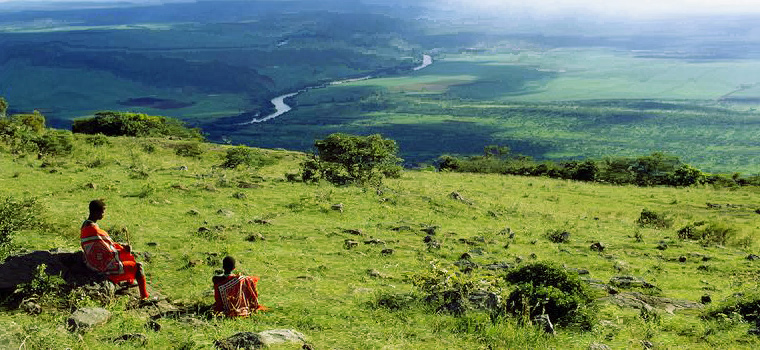
ESWATINI
"Emaswati Lamahle Nelive Lawo Lelihle Lelichakazile" fondly praises the majestic and flourishing Kingdom of Eswatini and her people. Radiating a traditional charm inherited from tales of warriors and kings of old, the beautiful monarchy today boasts a bold character given by the rich culture that is beautifully woven into what is known as modern day Eswatini.
HIS MAJESTY KING MSWATI III
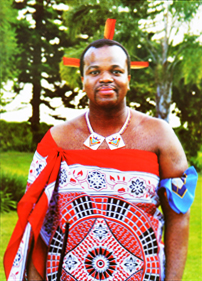
His Majesty King Mswati III was born at the Raleigh Fitkin Memorial Hospital in Manzini, Eswatini, on 19th April, 1968, that is a few months before Eswatini attained independence from Britain. At birth, he was named Makhosetive ("King of All Nations"). Prince Makhosetive was educated at Masundvwini Palace School and later went to Sherborne School in the United Kingdom until 1986 when he returned to Eswatini to be installed King of Eswatini. According to tradition, his official name and title became Mswati III.
As a young boy, Prince Makhosetive enjoyed marching and drilling to the extent that when he was four years he wanted to become a member of the royal guard. A year later his dream was fulfilled when he became the first young cadet to join the Umbutfo Eswatini Defense Force (USDF). Boys of his age later joined him. Prince Makhosetive took his military training seriously. When he was not at school, he spent his spare time training with the soldiers at the Masundvwini Military Barracks near Etjeni royal residence.
Prince Makhosetive was introduced to the Emaswati nation and the whole world at large as the Crown Prince in September 1983 and was crowned King of Eswatini on 25 April, 1986, at the age of 18, making him the youngest ruling Monarch in the world. The King and the Queen Mother of Indlovukazi (she-elephant), rule jointly.
HER MAJESTY INDLOVUKAZI
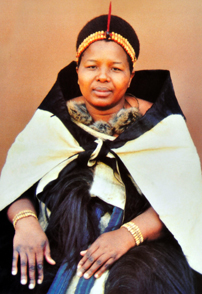
Her Majesty the Queen Mother (Indlovukazi) of the Kingdom of Eswatini has been the Indlovukazi (Great She-Elephant) since 1986. She was born Ntombi Tfwala and she is the Mother to His Majesty, King Mswati III. As per Emaswati custom, Her Majesty became Queen Mother when His Majesty King Mswati III was crowned as king of Eswatini. Prior to that, the Queen Mother was Regent of Eswatini from 1983 until 1986. In essence, the "Indlovukazi" is the Mother of the Emaswati nation, and as part of her traditional role, she rules together with His Majesty the King.
In accordance with Emaswati law and Custom and the Constitution, until a king is installed and has publicly assumed the functions and responsibilities of a king, or during any period when, by reason of absence from Eswatini, or any other cause, unable to perform the functions of his office, those functions are performed by the Queen Mother, acting as Queen Regent.
GEOGRAPHY
After the Gambia, Eswatini is the second smallest country on the continent of Africa. It is situated between Mozambique and South Africa. Its standard geographic coordinates are 26 30 S, 31 30 E. Eswatini has a total area of 17,363 square km. The Kingdom of Eswatini is almost the size of New Jersey in the United States of America and Wales in the United Kingdom.
Eswatini's border with South Africa is 430 km and its border with Mozambique is 105 km. Its climate varies from tropical to near temperate, and its terrain is mostly mountains and hills, with some moderately sloping plains and rivers (non-navigatable though). Its highest point is eMlembe (1,862 meters above sea level) and its lowest points are the Great Usutu River (21 meters above sea level).
Eswatini is more often referred to as "the Switzerland of Africa" because of its magnificent mountain scenery with unique, ancient rock formations, which have long been a source of fascination for geologists and scholars, as well as visitors. Within the small area each feature of Africa's terrain, apart from a desert, is found.
Eswatini comprises four topographical and climatic areas, which vary from 400 to 1800 meters above sea level, each with its own climate and characteristics, i.e. Highveld, Middleveld, Lowveld and the Lubombo Plateau.
HIGHVELD
The mountainous Highveld to the west comprises rivers, waterfalls and gorges and has a temperate climate of warm, wet summers and dry winters when the temperature can rise sharply during the day but with cold nights. It is a mountainous area to the west, not suitable for much agricultural activities. Consequently, most of it is given to forestry. It receives the highest rainfall almost throughout the year, ranging from 425 to 2706 millimetres annually.
MIDDLEVELD
The subtropical Middleveld is at a lower altitude. It is made up of lush, fertile valleys and has a warm climate ideal for cultivating various crops. It is here that much of agricultural activities occur. Lush, fertile valleys dominate this adjacent undulating area. Annual rainfall ranges from 444 to 1380 millimetres.
LOWVELD
Further east is the Lowveld, characterized by typical African bush vegetation, where a profusion of indigenous wild life, birds and flora may be found. Indigenous wildlife and flora abound which is also subtropical and is the largest region covering about 40% of the country. Two major export crops thrive in this area with extensive cattle farming carried out. Annual rainfall ranges from 217 to 1980 millimetres.
LUBOMBO PLATEAU
The smallest region is Lubombo and it borders with Mozambique. It has a subtropical climate, broken by gorges formed by the country's three main rivers en route to the Indian Ocean in Mozambique, running along the eastern length of the region. It has an average altitude of 600metres. Mixed farming occurs in this region.
HISTORY AND THE PEOPLE OF ESWATINI
The Kingdom of Eswatini is a landlocked country in Southern Africa, It is situated between Mozambique and South Africa.
The Emaswati people originate from Embu (Embo), a mountain range some 110 km northeast of Nairobi and 42 km south of Mount Kenia in the central part of Kenya. Known as the Bembo-Nguni, they moved south under Dlamini, whose name means 'he who eats in the middle of the day', and settled near the Maputo River in Mozambique.
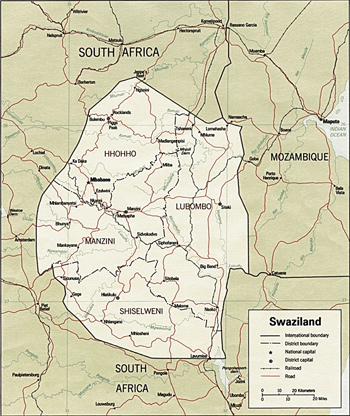
The Dlamini group moved into present day Eswatini during the middle of the eighteenth century, and named themselves bakaNgwane (the people of Ngwane) and the place where they settled they named it kaNgwane (meaning the country of Ngwane (now Eswatini). The name KaNgwane has remained and is the one by which the Emaswati people usually call themselves.
During the reign of Sobhuza I, he sent some of his men to Zwide, chief of the powerful Ndwandwe tribe in Natal, with the request that a girl be chosen whom he could marry and make the mother of his heir. Having put the matter before Zwide, the royal messengers asked him to allow them to make their choice of the bride-to-be according to Emaswati custom. Zwide gave permission and his daughters were called into the cattle-kraal and lined up according to their age groups. The leader of the Emaswati delegation came to the lines carrying the Emaswati royal special staff (umgobo), he asked the chosen girl to touch. Immediately she had done so there was a shout of 'Bayethe', a royal greeting, from all the Emaswati men. This was the signal that this child, whose name was Thandile (who became laZidze), was chosen as Sobhuza's wife. She became the mother of Mswati II.
During the reign of Sobhuza I, who laid the foundations of the Emaswati nation, the people of what is today is Eswatini, was known as "bakaSobhuza", meaning: "the people of Sobhuza". But it was Mswati II who succeeded in uniting the various clans, iincluding eMalangeni, Maseko, Shabalala, Maziya, etc into one nation and under one ruler. His people, therefore, began to be known as "bakaMswati', meaning: "the people of Mswati". Among the Whites; who had by then moved into the Transvaal, bakaMswati were known as the Emaswatis, and their land as Eswatini.
Mswati II died at his royal residence at Hhohho in July 1865, aged about 47. He was buried at the royal burial hill at Mbilaneni, down South, next to his father and great-grandfather.
Mswati's successor was the eleven-year-old Ludvonga, who died nine years later i.e. in 1874 and Mbandzeni became the new King in June 1875. He was known as Dlamini IV. When Mbandzeni died, he left as his heir a 14 years old son called Bhunu, who became Ngwane V.
Bhunu died during the night of 10 December 1899 and left a 4 months old son called Nkhotfotjeni, who was declared heir to the throne: He became Sobhuza II and he ruled from 1921-1982, becoming the longest reigning Emaswati Monarch. He died in 1982 and was succeeded by his son Makhosetive, which means "King of Nations", and was given the official title of Mswati III at his coronation in April 1986.
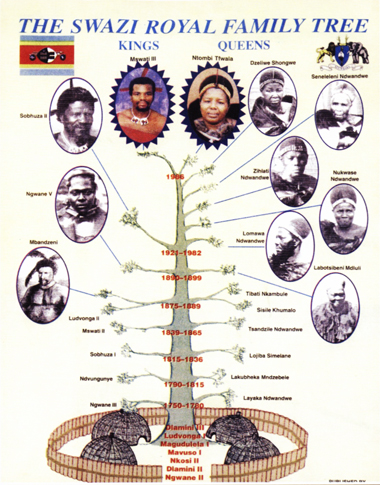
The Emaswati Royal Family Tree
King Sobhuza II, enthroned in 1921, and ruled the country for 61 years, becoming the world's longest ruling Monarch of his time, had a passionate commitment to preserving Emaswati traditions. His long reign, till his death in 1982, gave him every chance of achieving his aim.
In 1921 Eswatini established its first legislative body, an advisory council of elected European representatives mandated to advise the British High Commissioner on non-Emaswati affairs. Later on the High Commissioner conceded that the council had no official status and recognized the Paramount Chief (as the king was referred to by the British), as the native authority for the territory to issue legally enforceable orders to the Emaswatis. Consequently, in 1921 King Sobhuza II became the King of the Emaswati Nation.
A Constitution for limited self-government was introduced in 1963. In 1967 a revised Constitution transforms the Emaswati territory into a protected state as the Kingdom of Eswatini. During the same year Eswatini became a self-governing state when King Sobhuza II was recognised international as a king, and the country acquired its own flag. On 6 September 1968 independent status was attained.
Having shepherded his kingdom back to independence, King Sobhuza II established a latter-day version of an 18th-century enlightened form of government with absolute powers vested in him. In 1973 he scrapped the Constitution devised under British guidance and reverted to a traditional system of government with all effective power in royal hands. However, he retained the outward form of government led by a Prime Minister and Cabinet.
The result of this move was a period of stability and progress for the Kingdom of Eswatini, with a new emphasis, as far as the economy would allow, on improvements in education and health.
However, as a result of the fast changing political dispensations around the world, in 1978 King Sobhuza II decided to introduce an experimental form of democracy, in which traditional local groups (the tinkhundla) elect Members of Parliament on the basis of universal right to vote for people over the age of 18.
